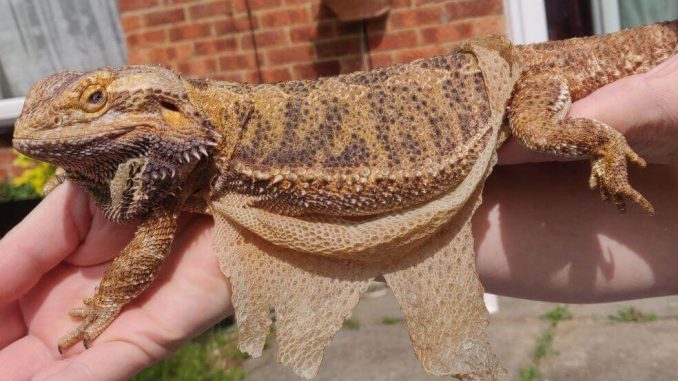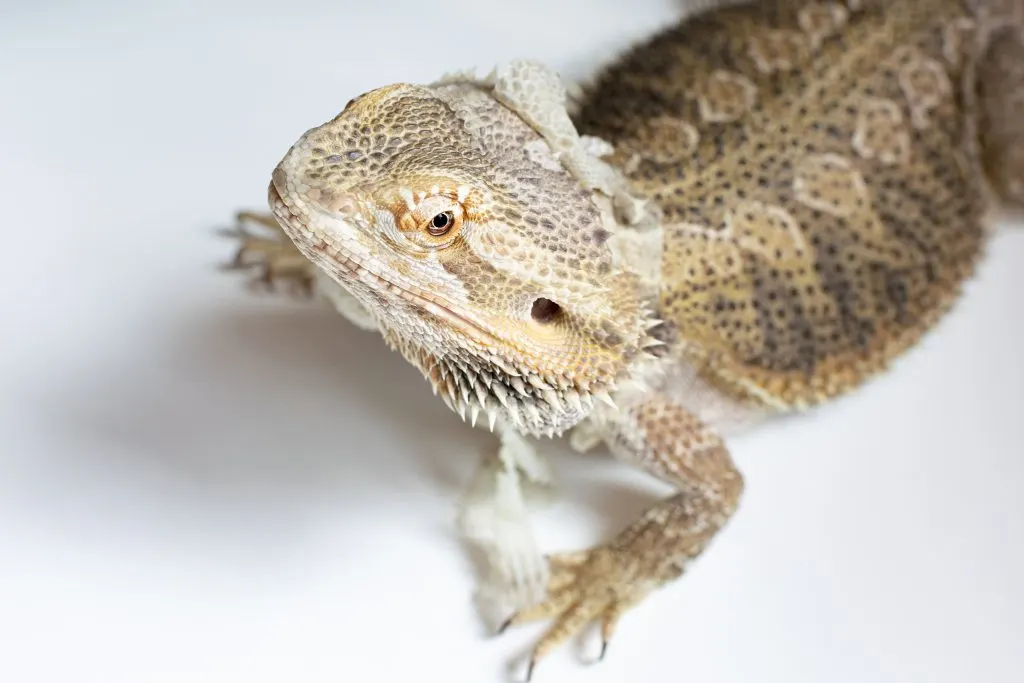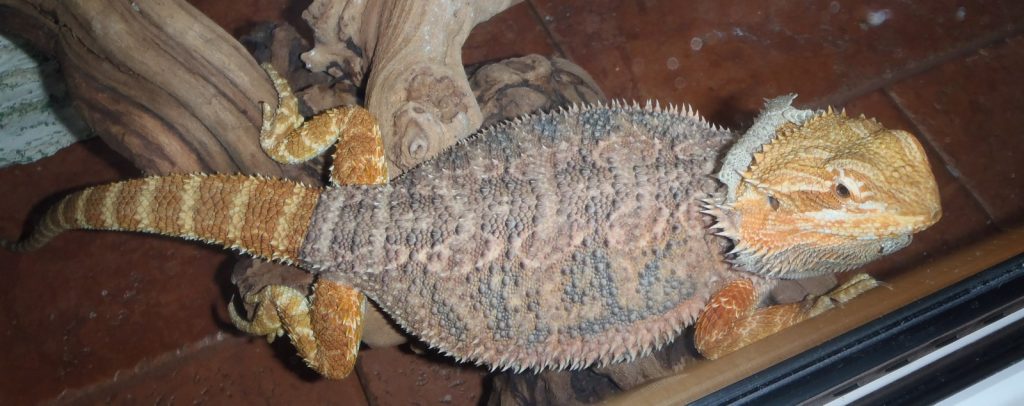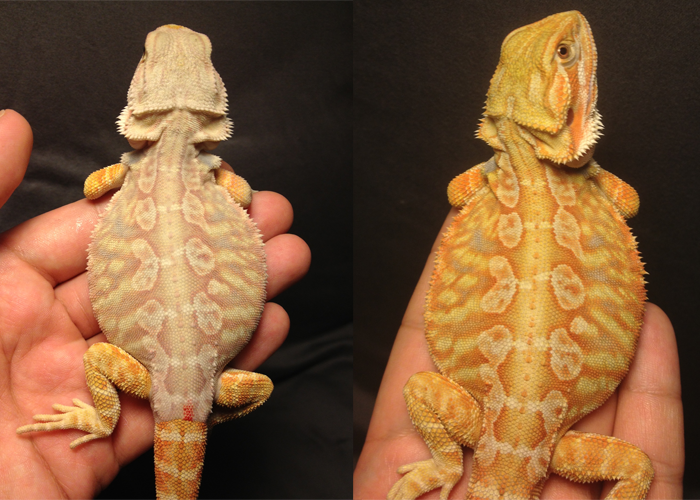Hey there bearded dragon owners! If you’ve made it to here then probably your beardie is going through a shedding cycle and you want to know how to care for them. Well don’t worry, you’ve come to the right place!
All healthy bearded dragons go through a natural process of shedding. This may take between a few days up to two weeks until it is finished.
Young dragons usually shed their entire skin every week, while adult bearded dragons shed less frequently, in patches.
Here we will discuss, your beardies behavior during this process , learn about excessive bearded dragon shedding and how to take care of your beardie during the process.
Why Bearded Dragons Shed?
Bearded dragons shed their skin because it’s part of their natural growth and development. Their skin is made up of keratinized scales which is inelastic.
As adult bearded dragons grow, their old skin becomes too small and uncomfortable, so they must shed in order to grow. This is a process of the bearded dragon pushing off their old top layer of skin, which is replaced by new skin underneath it.
For healthy growth, it’s also important that bearded dragons get enough Vitamin D, nutrients, and other minerals to maintain a healthy layer of skin. Without these essential components, their skin won’t grow properly and they won’t be able to shed.
Unfortunately, when the bearded dragon has done its shedding, it will display signs of stress and restlessness until the new skin hardens. This process in bearded dragons typically begins when they are young, and will happen periodically throughout their adulthood. It’s usually more frequent when they’re young and will slow down as they age.
As the beardie grows, their skin gets stretched and wrinkled, especially around the tail and back which is a clear indication that it’s time to shed. Additionally, the scales may appear lighter or duller in color than usual due to the old skin peeling away.
Bearded Dragon Shedding Process
Growth Shedding

The shedding process of a bearded dragon, also known as Ecdysis, is an important part of the animal’s life cycle, allowing it to grow and mature.
During the process, the dragon’s old, dead skin will slough off to make way for the new skin underneath. It typically begins around 8 weeks of age and continues through adulthood.
Before beginning this process, a dragon will usually stop eating for a few days. This is normal – they are getting ready to shed, so their appetite decreases. During the process, the dragon will generally become fatigued and lose its appetite further.
The dragon will rub itself against hard surfaces like rocks and logs. This is helps to remove the outer layer of dead skin and make it easier for the dragon to shed.
The dragon may also become more lethargic and inactive. While the dragon is shedding, its old skin may lose its color and become dull gray or pale pink.
The skin will start to peel off in large sections or patches. You may also be able to see small areas of new pink skin emerging underneath.
To help remove stuck skin, you can bathe the dragon in warm water. Patience is key during the shedding process, as it can take anywhere from ten days to several weeks for the whole skin to come off.
Once the shedding is complete, the dragon will likely have a full appetite and energy level. For proper nutrition and hydration, feed it a varied diet
Stress Shedding

Stress shedding is triggered anytime the dragon is exposed to stressors. This can be things likes changes in diet, environment, health, and even changes in temperature.
In this situation, the dragon quickly shed its entire skin layer in order to try and protect itself. It is normal for a bearded dragon to spend up to 6 hours per day preening and getting ready for shedding.
During the process, the dragon’s skin becomes dull in color and white patches will appear. These patches indicate areas where the new skin is forming underneath the old skin.
Eventually the old skin will begin to crack and peel off and the dragon will appear brighter in color as the underneath skin is revealed.
How Often Do Bearded Dragons Shed?
Bearded dragons will go through a continuous process of outgrowing their skin throughout their lifetime. The rate of shedding depends on several factors such as age, habitat, and health of the dragon.
Typically, juvenile dragons shed more often than adults, and they tend to shed every two to three weeks. Adult dragons will shed in lesser frequency and may only need to do it every few months.
The rate of shedding in bearded dragons depends on several factors. Juvenile bearded dragons generally shed every two to three weeks, while adults only shed every few months.
The age of the dragon will affect the amount and frequency of shedding. Baby bearded dragons shed more frequently as they develop and grow. As they grow they will shed less often.
Shedding Frequency in Bearded Dragons by Age:
| Age | Shedding Frequency | Reason for Shedding |
| Hatchling | 3 to 4 Weeks | Growth |
| Juvenile | 4 to 8 Weeks | Growth |
| Sub-Adult | 4 to 8 Weeks | Growth |
| Maturing Adult | 4 to 6 Months | Natural Wear and Tear |
When they are newly hatched, bearded dragons will shed their skin approximately every 3-4 weeks. As they grow into juveniles and sub-adults, the shedding frequency increases to 4-8 weeks due to their growing size. Adults will typically shed their skin every 4-6 months as a result of natural wear and tear.
The habitat and enclosure temperature is also a factor in the shedding of the dragon. Living in an environment below their desired temperature range will shed less often than those living in an enclosure with optimal temperatures.
Lastly, the health of the dragon affects shedding. Poor nutrition and stressful living conditions can cause shedding to slow down or stop. If your beardie isn’t shedding regularly, it may be worth looking into the other factors that may be causing it to stop.
The amount and frequency of shedding also depend on the habitat and overall health of the dragon. To ensure healthy shedding, it’s important to provide your dragon with the optimal environment and nutrition.
Is Your Bearded Dragon Shedding Too Much? Causes of Excessive Shedding

Although shedding is a natural process of a beardies growth, too much shedding can be a warning sign of your beardie’s health! If your bearded dragon starts to shed excessively, it is a sign that something may not be right.
The excess shedding can lead to discomfort for the dragon, making them more likely to be diagnosed with illnesses or injuries.
The excess shedding can take its toll on the dragon’s skin. If your dragon shed skin too frequently it leaves them open to irritation and infections. In more extreme cases, retained skin bands can form around the tips of toes and tail.
And if left untreated, this can cause the affected area to die and eventually fall off. This condition is known scientifically as dysecdysis.
To determine the cause of this issue in your dragon, here are some factors that you have to pay attention to:
Improper Nutrition: Improper nutrition is one of the major causes of excessive shedding in Bearded Dragons. A diet low in Vitamins A, D, and E, and high in protein can cause health issues, including poor skin and shedding.
It is important for bearded dragons to get a balanced diet including sources of non-animal proteins such as shredded carrots, squash, and sweet potatoes.
High Humidity: High humidity is another factor that can lead bearded dragon to shed excessively. High humidity can make it difficult for the dragon to properly shed its skin, leading to patches of retained skin. It is important to provide a habitat with the appropriate humidity level for your bearded dragon, typically between 40-60%.
Stress: Stress is a major contributor to excessive shedding in Dragons. Stress can be caused by anything from loud noises, to an unclean habitat, to improper temperatures. If the dragon is under stress, it can cause their health to decline and can result in excess shedding.
Parasites: Parasites, such as mites and ticks, can cause shedding issues in bearded dragons. Parasites feed off the blood of the dragon and can interfere with their ability to shed properly. If your dragon has parasites, they should be treated promptly to reduce any health issues.
Light: Lighting is an important factor when it comes to the health of your beardie. Too little light can cause shedding issues, as the dragon’s body will produce too much keratin, leading to skin retention. Additionally, too much light can also cause shedding as they become too hot and start to shed excess skin.
Skin Infection: Skin infections in bearded dragons can be caused by anything from poor hygiene to a vitamin or mineral deficiency. If your dragon has a skin infection, it can lead to excessive pieces of skin that will not shed. These infections should be treated promptly to reduce the chance of shedding issues.
Bacterial Infections: Bacterial infections are another common cause of shedding issues in dragons. These infections can cause your dragon to shed excessively due to inflammation of the skin and/or irritation. Bacterial infections should be treated promptly to keep shedding under control.
Low Temperatures: Low temperatures are another major contributor to excessive shedding. If the temperature in the habitat is too low, it can cause the dragon’s skin to become too dry and flaky. It is important to provide your dragon with a habitat with the appropriate temperature to reduce the chance of shedding.
Dehydration: Dehydration can also cause issues in your pet dragons. If the dragon does not have enough water in its body, it will start to shed excessively.
Poor Water Quality: Poor water quality can also cause problems in bearded dragons. If the water in the drinking bowl or bathtub is too dirty or of poor quality, it can cause the dragon’s skin to become irritated and lead to excessive shedding. It is important to provide your dragon with clean, filtered water to reduce the chance of any issues.
12 Signs of Shedding & Bearded Dragon Shedding Behavior

Your bearded dragon may act in certain types of once it starts shedding. Here are the signs you can see in your bearded dragon’s behavior-
1. Changes in Skin Color: The reptiles are typically lighten in color once they are about to shed. It may take on a grayish cast or become paler than their usual color.
2. Dulled Eyes: The eyes of the bearded dragon will lose their luster and may appear white or cloudy in color.
3. Skin Rubbing and Claws: The bearded dragon may rub its skin, claws, and the scales around its eyes against anything to help loosen the skin.
4. Loss of Appetite: During shedding, bearded dragons will often forgo eating in favor of shedding activities.
5. Frequent Scratching: The dragon may scratch at themselves frequently as a means of aiding in shedding.
6. Shedding Skins: As shed skin is easily visible, its presence is a sign that your pet is in the shedding process.
7. Small White Spots: These spots indicate that old and new skin are separating.
8. Change in Claws: Claws become duller and less sharp during shedding.
9. Softening Skin: The skin often feels softer to the touch as it comes off.
10. Light Skin Shedding: In some cases, the skin may be shed in patches, resulting in a checkerboard look.
11. Rubbing Against Objects: Bearded dragons may rub against objects in an attempt to remove old skin.
12. Scabbing: Shedding by dragons can create scabs in places where extreme shedding has occurred.
Shedding Beardie Care Tips – Help Your Bearded Dragon to Shed
Bearded dragon owners should watch closely when their pet is shedding its skin. Proper monitoring can help ensure a safe and healthy process. Here are some helpful tips for beardie owners during this time:
1. Provide a Moist Environment
Make sure the tank is well-ventilated and properly humidified. Increase the humidity levels in the tank to around 75%. This will help your beardie shed its skin quickly and more easily.
2. Offer Shedding Aids
Provide shedding aids such as a moist hide or humidifier box. This will help maintain the humidity levels needed for shedding and will also be a comforting enclosure for your beardie while it’s shedding.
3. Regularly Soak Your Dragon
A warm bath with shallow water (no deeper than your dragon’s feet) can help to loosen and remove excess skin. For best results, give your dragon a bath twice a week while its shedding.
4. Don’t Overfeed
Overfeeding may slow down shedding and is not advisable when your beardie is already shedding.
5. Supplement With Calcium
Make sure to supplement your beardie’s diet with calcium during shedding. Calcium helps the exoskeleton harden and is essential for healthy shedding.
6. Regularly Check Your Dragon
Regularly check your dragon for any signs of retained shed. If any skin is retained, gently help your dragon to remove it.
Bearded Dragon Not Shedding Properly? Help Shedding Bearded Dragon
Bearded dragons can often become stuck during their shedding process. To help your bearded dragon shed, here are few things you can do:
Use Reptile Shedding Aid

First separate their skin from the tissue beneath with a pair of tweezers. Gently pull away the skin from the tissue until the original shape of your bearded dragon is visible again.
Once the skin is removed, you can then inspect the area to see if there are any areas of stuck shed still present. If so, use some unscented baby oil, or coconut oil applied with a damp cloth or cotton balls to help soften and remove the remaining chunks of stuck shed.
Be sure to not apply too much oil and avoid getting it in your bearded dragon’s eyes and nose.
Increase the Humidity
Proper humidity levels are key for a healthy bearded dragon. Make sure to provide your bearded dragon with an environment of 25-50% humidity to help soothe the shedding process.
Soak the Reptile
Giving your bearded dragon regular soaks can help soften the skin and loosen the shed. Soak the reptile for about 10 minutes every day, or as needed.
Use Shed Ease
Shed Ease is a product specially formulated to help with the shedding process. Apply the product to your pet’s skin and it will provide moisture and lubrication, helping to ease shedding.
Soften the Area with Vaseline
An old trick to help soften stuck shed is to rub a small amount of Vaseline or cooking oil into the stuck area. You can also try a much diluted version of white vinegar to help dissolve the stuck shed.
Gently Remove Any Stuck Shed
If softer methods do not work, sometimes it is necessary to use an implement to help remove the stuck shed. Use a damp cotton swab, warm damp wash cloth, or a blunt-edged tool such as a spoon to gently loosen the edges of the skin.
Take care to be gentle, as it is possible to cut or damage the skin while trying to remove the stuck shed.
Consult Your Veterinarian
If methods such as soaking, humidity, or Shed Ease still do not help with the stuck sheds, it is best to consult with your veterinarian as there may be an underlying health issue causing the shedding difficulty.
It’s important to pay close attention to the area where the shedding occurred for any signs of infection. If you notice any redness, swelling, or a foul odor, your beardie may have a skin infection and may require immediate medical care.
FAQ’s
What do you do when your bearded dragon is shedding?
When your bearded dragon is shedding, it is important to provide them with a moist warm environment. Use a shallow water dish to increase humidity and create a warm damp hide. You may also want to lightly mist your dragon with a spray bottle once or twice a day to help the shedding process. Ensure your dragon is consuming a nutritious diet and has access to calcium supplements, as this will help to promote healthy shedding.
How long does bearded dragon shedding last?
Generally, the shedding process for a bearded dragon takes longer as the dragon ages; however, shedding is much quicker for juveniles and hatchlings.Hatchlings go through the shedding process every week, and it may take them up to 3 days to complete. For juvenile bearded dragons, the shedding usually occurs every 4-6 weeks, while sub-adults go through the process about once a month.
What months do bearded dragons shed?
Bearded dragons typically shed about once every 2 – 4 weeks. This process usually occurs during the spring and summer months, when the days become longer and their growth rates are increased. It may also occur at other times of the year as their scales and skin break down and get replaced with new layers.
Are bearded dragons grumpy when shedding?
Bearded dragons usually are not grumpy when shedding. They may appear to be more lethargic during this time, but generally, they do not get irritable. It is important to make sure they have a warm environment and access to a humidity hide to make sure their shedding process goes smoothly.



